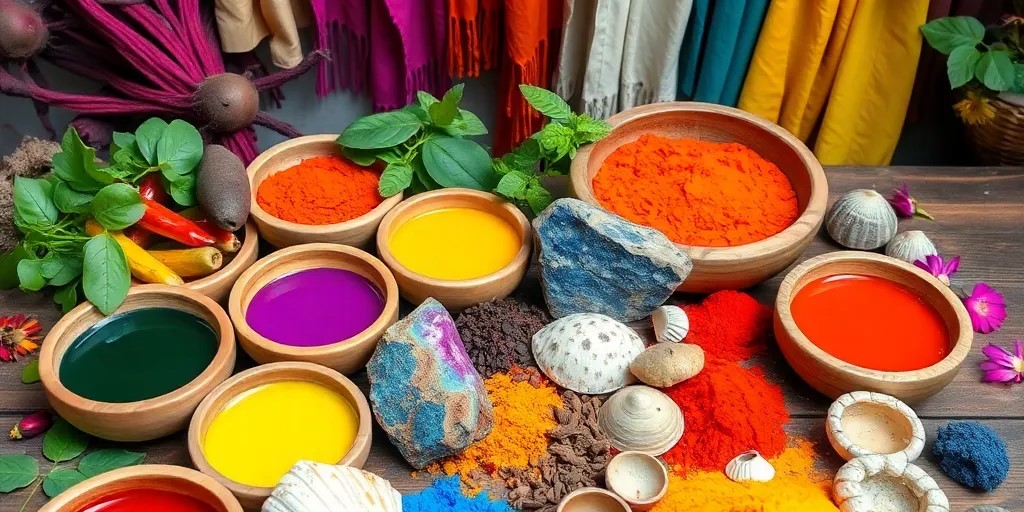People have always been captivated by colors. In the case of natural colors, it is not just beauty, but the combination of tradition, science, culture, and environment. However, although the value of natural colors has decreased a bit since artificial colors were introduced, in the present age, natural colors have once again regained the discussion to seek solutions that are environmentally friendly. Today, we will know the secret of making natural colors, its history, process, and why it is important in our lives.
The beginning story of natural colors
Humans' relation with color has been ancient. Early people
used colors on cave walls to tell their stories. It was the most primary use of
natural colors. They were made out of leaves, soil, flowers, roots, and
minerals.
Egyptian Civilization: The Egyptian pharaoh's robes
wore bright blue and golden colours. The vibrant pictures, which depict the
glories of Egypt, exist until today.
Indian Civilization: "Indigo," that is the
"Blue colour" is so revered in India that during British regime, this
was being termed as "Blue gold"
Roman Empire: Romans used a very special type dye, Tyrian Purple which were produced from the secretion extracted from Sea snails
Nature Source of Dyes
These have traditionally been grouped into two
sources—vegetable and mineral.
Vegetable Sources
It is quite interesting that such a variety is obtained from
plant-based sources. Here are some:-
Indigofera tinctoria: The same dye which makes blue
is procured from this plant.
Madder Root: A wonderful deep red color is obtained
from roots of the madder tree
Turmeric: Again, roots or tubers of a tree can give
the required brilliant yellow colour
Minerals
This method of natural dyeing has been in existence for
thousands of years. It involves producing natural dyes from minerals.
Red oxide: This is the earth product that produces a
bright red dye.
Azurite: This is a mineral used to produce bright
blue dyes.
Animal Sources
Some dyes are made
from animals.
Cicada beetle: Deep red dye is prepared from this
insect.
Tyrian Purple: Such was the expense of this dye from
sea snails that it was reserved exclusively for emperors and elites.
Natural dye making process
Making of natural dyes is quite a creative and time-taking
process. It has a number of steps involved with it:-
Raw material gathering
The first step for making natural dyes involves gathering raw materials. Like,
Gathering of the leaves of the Indigofera plant or roots of
the madder plant.
Preparation of materials such as flowers, leaves, and roots
for processing.
Making the extract
The ingredients boiled or fermented to extract the indigo.
To make indigo, the leaves of the plant are fermented and
their extract is collected.
Dried and powdered madder roots make a red dye.
Use of mordants
A mordant is a chemical that enhances the stability of the
dye. It makes the bond of the dye to the fabric or other materials strong.
Some of the commonly used mordants include aluminum sulfate
and iron sulfate.
Application of colors
Finally, the natural colors are applied to the fabric or any other surface. This is done by dipping the fabrics in the extract and then drying them.
Historical importance
Natural colors were not only part of our daily life, but
were also symbols of social status.
Expression of power through colors
Tyrian Purple: It symbolized aristocracy in the Roman
Empire. Only emperors and senators could wear it.
Indigo: This was also a valuable commodity. The
Middle Ages saw it become a symbol of trade and power.
Cultural and religious uses
It was used in various religious and cultural ceremonies.
The Holi festival of India can be cited as an example of
using different natural colors.
Natural colors were applied to mummies in Egypt before their
preparation.
Application of Natural Colors in the Modern Era
Although artificial colors dominate the market, the demand
for natural colors is still there.
Non-Polluting
Natural colors are non-polluting. They do not pollute water
or soil.
Healthy
Natural colors are absolutely non-toxic to the environment.
Natural colors are non-toxic to the skin as opposed to
artificial colors. It does not cause allergy or rashes.
Sustainable Fashion
Today, most fashion brands are making use of natural colors.
"Eco-friendly" fashion has increased the use of natural colors day by
day.
Challenges and Solutions
Challenges
The materials for making natural colors are not easily
available.
Its production is expensive and time-consuming.
The strength of colors is relatively lesser than that of
artificial colors.
Solutions
Technology development for making natural colors.
Special agriculture initiative for raw material.
Creating awareness and increasing market.
Future Scope
Through the research and innovation on natural colors, it
can be the alternative for artificial colors to become sustainable. It can play
an important role in protecting the environment and health.
Education and Awareness
This popularity can increase by showcasing the relevance of
natural colors at school as well as college levels curricula.
Industry and Technology
Increased usage of the natural colours can be induced in industrial areas to suit the vision of sustainable developments.
Conclusion
Natural colors are not just colors; they symbolize culture,
history, and a sustainable future. Its use is not only a connection to the past
traditions but also necessary for the environment and health. We should be
aware of natural colors and increase their use.
Do you have any memories to share with natural colors? Share
your thoughts and let's spread the importance of natural colors together!
















0 Comments